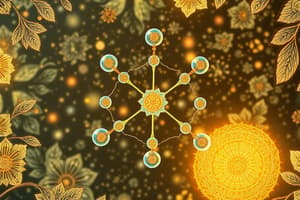Podcast
Questions and Answers
What happens to atoms in an ionic bond?
What happens to atoms in an ionic bond?
- They lose protons
- They gain neutrons
- They share electrons
- They transfer electrons (correct)
Which atom becomes negatively charged in an ionic bond?
Which atom becomes negatively charged in an ionic bond?
- Cation
- Anion (correct)
- Proton
- Neutron
What determines the bond strength in modern bond valence theory?
What determines the bond strength in modern bond valence theory?
- Number of electrons shared and their distribution (correct)
- Number of neutrons
- Number of protons
- Atomic weight of the elements
What is the role of Crystallographic Information Framework (CIF) in studying ionic bonding?
What is the role of Crystallographic Information Framework (CIF) in studying ionic bonding?
Which type of compounds commonly exhibit ionic bonds?
Which type of compounds commonly exhibit ionic bonds?
In an ionic bond, what charge does the atom losing electrons acquire?
In an ionic bond, what charge does the atom losing electrons acquire?
Which type of theory helps in predicting the properties of ionic compounds?
Which type of theory helps in predicting the properties of ionic compounds?
What does the professor's modern bond valence theory focus on in understanding ionic bonding?
What does the professor's modern bond valence theory focus on in understanding ionic bonding?
What is the key feature of an anion in an ionic bond?
What is the key feature of an anion in an ionic bond?
Which software system is used for managing crystallographic information related to ionic bonding?
Which software system is used for managing crystallographic information related to ionic bonding?
Flashcards are hidden until you start studying
Study Notes
Exploring Ionic Bonds: The Foundations of Chemical Bonding
Chemical bonding, the forces that link atoms together, is a fundamental concept in chemistry. Among these bonds, ionic bonds hold a special place in our understanding of chemical structure and behavior.
The Nature of Ionic Bonds
Ionic bonds form when electrons are transferred between atoms of different electronegativities, causing one atom to gain electrons and become negatively charged (anion), and the other to lose electrons and become positively charged (cation). These charged ions are then attracted to each other, creating a stable ionic compound.
Modern Bond Valence Theory
Professor Brown's modern bond valence theory offers a simple and intuitive method for understanding and predicting ionic bonding. In this approach, the bond strength is determined by the number of electrons shared and their distribution. This theory can be used to model and predict the properties of ionic compounds and their structures.
Crystallographic Information Framework
Professor Brown also developed the Crystallographic Information Framework (CIF), a software system for managing and exchanging crystallographic information. CIF is an important tool for studying ionic bonding, as it allows chemists to analyze and interpret the structures of ionic compounds.
Examples of Ionic Bonds and Their Properties
Ionic bonds are present in many common compounds, such as table salt (NaCl) and calcium carbonate (CaCO3). Ionic compounds tend to be soluble in water, form crystalline solids, and exhibit high melting and boiling points due to the strong electrostatic forces between ions.
Summary
Ionic bonds are a crucial component of chemical bonding, forming stable compounds through the transfer of electrons between atoms. Modern bond valence theory offers a simple and efficient tool for understanding and predicting ionic bonding, while the Crystallographic Information Framework aids in the analysis and interpretation of ionic compound structures.
Studying That Suits You
Use AI to generate personalized quizzes and flashcards to suit your learning preferences.




